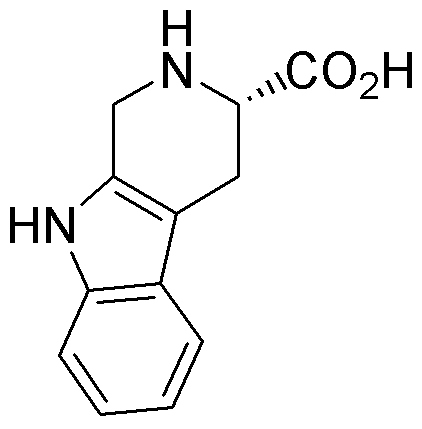L-1,2,3,4-Tetrahydronorharman-3-carboxylic acid is widely utilized in research focused on:
- Pharmaceutical Development: This compound serves as a valuable intermediate in the synthesis of various pharmaceuticals, particularly those targeting neurological disorders, enhancing drug efficacy and specificity.
- Neuroscience Research: It is used in studies investigating the effects of neurotransmitters and neuroprotective agents, providing insights into brain function and potential treatments for cognitive decline.
- Analytical Chemistry: The compound is employed in analytical methods to detect and quantify related indole derivatives, aiding in the quality control of pharmaceutical products.
- Biochemical Studies: Researchers utilize it to explore its role in enzyme inhibition and metabolic pathways, contributing to a better understanding of biochemical processes.
- Natural Product Synthesis: It is involved in the synthesis of natural products, which are essential for developing new drugs, showcasing its versatility in organic chemistry.
General Information
Properties
Safety and Regulations
Applications
L-1,2,3,4-Tetrahydronorharman-3-carboxylic acid is widely utilized in research focused on:
- Pharmaceutical Development: This compound serves as a valuable intermediate in the synthesis of various pharmaceuticals, particularly those targeting neurological disorders, enhancing drug efficacy and specificity.
- Neuroscience Research: It is used in studies investigating the effects of neurotransmitters and neuroprotective agents, providing insights into brain function and potential treatments for cognitive decline.
- Analytical Chemistry: The compound is employed in analytical methods to detect and quantify related indole derivatives, aiding in the quality control of pharmaceutical products.
- Biochemical Studies: Researchers utilize it to explore its role in enzyme inhibition and metabolic pathways, contributing to a better understanding of biochemical processes.
- Natural Product Synthesis: It is involved in the synthesis of natural products, which are essential for developing new drugs, showcasing its versatility in organic chemistry.
Documents
Safety Data Sheets (SDS)
The SDS provides comprehensive safety information on handling, storage, and disposal of the product.
Product Specification (PS)
The PS provides a comprehensive breakdown of the product’s properties, including chemical composition, physical state, purity, and storage requirements. It also details acceptable quality ranges and the product's intended applications.
Certificates of Analysis (COA)
Search for Certificates of Analysis (COA) by entering the products Lot Number. Lot and Batch Numbers can be found on a product’s label following the words ‘Lot’ or ‘Batch’.
*Catalog Number
*Lot Number
Certificates Of Origin (COO)
This COO confirms the country where the product was manufactured, and also details the materials and components used in it and whether it is derived from natural, synthetic, or other specific sources. This certificate may be required for customs, trade, and regulatory compliance.
*Catalog Number
*Lot Number
Safety Data Sheets (SDS)
The SDS provides comprehensive safety information on handling, storage, and disposal of the product.
DownloadProduct Specification (PS)
The PS provides a comprehensive breakdown of the product’s properties, including chemical composition, physical state, purity, and storage requirements. It also details acceptable quality ranges and the product's intended applications.
DownloadCertificates of Analysis (COA)
Search for Certificates of Analysis (COA) by entering the products Lot Number. Lot and Batch Numbers can be found on a product’s label following the words ‘Lot’ or ‘Batch’.
*Catalog Number
*Lot Number
Certificates Of Origin (COO)
This COO confirms the country where the product was manufactured, and also details the materials and components used in it and whether it is derived from natural, synthetic, or other specific sources. This certificate may be required for customs, trade, and regulatory compliance.


